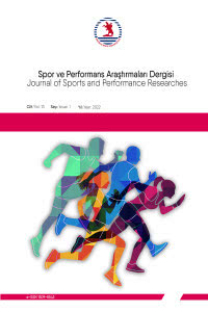EĞİM ANTRENMANLARININ SPRİNT KOŞU PARAMETRELERİNE ETKİSİ
koşu, eğim koşuları, adım uzunluğu, adım frekansı, performans
EFFECTS OFSLOPE TRAINING ON SPRINT RUNNING PARAMETERS
Running, slope surface running, stride length, stride frequency, performance,
___
- Brüggemann GP, Glad B. Biomechanical analyses of the jumping events: Time analysis of the sprint and hurdle events. In: IAAF Scientific Research Project at the Games of the XXIVth Olympiad – Seoul, Final Report. IAAF, Monaco, 1988
- Ferro A, Rivera A, Pagola I, Ferreruela M, Martin A, Rocandio V. Biomechanical analysis of the 7th World Championships in Athletics Seville 1999. New Stud. Athl. 2001;16:25-60
- Babić V, Čoh M, Dizdar D. Differences in Kinematic Parameters of Athletes of Different Running Quality, Biol. Sport 2011;28(2):115-121, doi:10.5604/946493
- Debaere S, Jonkers I, Delecluse C. The Contribution of step characteristics to sprint running performance in high level male and female athletes, Journal of Strength and Conditioning Research, 2012; 27(1)/116-124, doi: 10.1519/JSC.0b013e31825183ef
- Chatzilazaridis I, Panoutsakopoulos V, Papaiakovou G. Stride characteristics progress in a 40-m sprinting test executed by male preadolescent, adolescent and adult athletes. Biology of Exercise, 2012; 8(2): 58-77, doi:10.4127/jbe.2012.0060
- Padulo J, Annino G, Migliaccio GM, D’ottavio S, Tihanyi J. Kinematics of running at different slopes and speeds, Journal of Strength and Conditioning Research, 2012; 26(5):1331–1339, doi: 10.1519/JSC.0b013e318231aafa
- Hunter JP, Marshall RN, Mc Nair PJ. Interaction of step length and step rate during sprint running. Med Sci Sports Exerc, 2004; 36:261-271, doi: 10.1249/01.MSS.0000113664.15777.53
- Mero, A, Komi, PV, Gregor, RJ. Biomechanics of sprint running. Sports Med, 1992; 13:376-392
- Mero A, Komi PV. Effect of supramaximal velocity on biomechanical variables in sprinting. Int J Sport Biomech, 1985; 1: 240–252, doi: 10.1123/ijsb.1.3.240
- Luhtanen R, Komi PV. Mechanical factors influencing running speed. [w:] Assmussen, Jorgensen (red.), Biomechanics VI-B. International series on Biomechanics, 2 B, 1978:23–29
- Milakov M, Cox V. Improving speed by training on sloping surfaces. Track Technique. 1962;8:254–255.
- Paradisis GP, Bissas A, Cooke, CB. Combined uphill and downhill sprint running training is more efficacious than horizontal. International Journal of Sports Physiology and Performance. 2009;4:229-243, doi:10.1123/ijspp.4.2.229
- Paradisis GP,Cook CB. The effects of sprint running training on sloping surface. National Strength and Conditioning Assosiation, Journal of Strength and Conditioning Research, 2006; 20(4):767-777, doi: 10.1519/R-16834.1
- Ebben WP, Davies JA, Clewien RW. Effects of Degree of Hill Slope on Acute Downhill Running Velocity and Acceleration, Journal of Strength and Conditioning Research, 2008; 22(3): 898-902, doi: 10.1519/JSC.0b013e31816a4149
- Kunz H. Kaufmann D. Biomechanics of hill sprinting, Track Tech, 1981; 82: 2603-2605
- Dintiman G,Ward RW, Tellez T. Sports speed, 2nd ed. Champaign, IL: Human Kinetics, 1998
- Cetin E, Hindistan IE, Ozkaya YG. Effect of Different Training Methods on Stride Parameters in Speed Maintenance Phase of 100m Sprint Running, Journal of Strength and Conditioning Research, doi: 10.1519/JSC.0000000000001977
- Arakawa K. Biomechanical study on downhill running for sprint training, Research Reports of Kanagawa Institute of Technology, 1993; A-17:1-4
- Baron B, Deruele F, Molullan F, Dalleau G, Verkindt C, Noakes TD. The eccentric muscle loading influences the pacing strategies during repeated downhill sprint intervals, European Journal of Applied Physiology, 2009; 105(5):749-757, doi: 10.1007/s00421-008-0957-6
- Paradisis GP, Cooke CB. Kinematic and postural characteristics of sprint running on sloping surface, Journal of Sports Sciences, 2001; 19:149-159, doi: 10.1080/026404101300036370
- Paradisis GP, Bissas A, Cooke CB. Changes in leg strength and kinematics with uphill-downhill sprint training, International Journal of Sports Science and Coaching, 2013; 8(3):543-556, doi: 10.1260/1747-9541.8.3.543
- Padulo J, Ardigo LP, Attene G, Cava C, Wong DP, Chamari K and et al. The effect of slope on repeated sprint ability in young soccer players, Research in Sports Medicine, 2016; 24:4, 320-330, doi: 10.1080/15438627.2016.1222276
- Padulo J, Powell D, Milia R, Ardigo LP. A paradigm of uphill running, PLoS ONE, 2013; 8(7): e69006. doi:10.1371/journal.pone.0069006
- Snyder LK, Farley CT. Energetically optimal stride frequency in running: the effects of incline and decline, The Journal of Experimental Biology, 2011; 214(Pt 12):2089-2095, doi: 10.1242/jeb.053157
- Swanson SC, Caldwell GE. An integrated biomechanical analysis of high speed incline and level treadmill running. Med Sci Sports Exerc., 2000;32(6):1146–55.
- Klein RM, Potteiger JA, Zebas CJ. Metabolic and biomechanical variables of two incline conditions during distance running, Medicine and Science in Sports and Exercise, 1997; 29(12):1625–1630.
- Hamill CL, Clarke IE, Frederick EG, Goodyear LJ, Howley ET. Effects of grade running on kinematics and impact force, Medicine and Science in Sports and Exercise, 1984; 16(2):185.
- Chu D, Korchemny R. Sprinting stride actions: Analysis and evaluation. 6, National Strength & Conditioning Association Journal., 1989, Cilt 11, s. 6-9
- Mackala, K. Optimisation of performance through kinematic analysis of the different phases of the 100 metres. New Studies in Athletics, 2007; 22(2): 7-16
- Armstrong, L, Costil, LD, and Gehlse, D. Biomechanical comparison of university sprinters and marathon runners. Track Tec 87:2781–2782,1984.
- Summers, RL. Physiology and biophysics of the 100 m sprint. News Physiol Sci 12: 131-136, 1997
- Shen, W. The effects of stride length and frequency on the speeds of elite sprinters in 100 meter dash, Biomechanical Proceedings of XVIII International Symposium of Biomechanics in Sports, Hong- Kong, 2000. pp. 333-336.
- ISSN: 1309-5110
- Yayın Aralığı: 3
- Başlangıç: 2010
- Yayıncı: Ondokuz Mayıs Üniversitesi Yaşar Doğu Spor Bilimleri Fakültesi
DOĞA SPORLARI FAALİYETLERİNE KATILAN SPORCULARIN PSİKOLOJİK PERFORMANSLARININ İNCELENMESİ
BURAK GÜRER, FATİH BEKTAŞ, BURAK KURAL
EĞİM ANTRENMANLARININ SPRİNT KOŞU PARAMETRELERİNE ETKİSİ
İKİ FARKLI ÖZEL EĞİTİM VE REHABİLİTASYON MERKEZİNİN FİZİKSEL AKTİVİTE PROFİLİNİN İNCELENMESİ
Bekir Erhan ORHAN, Erkan YARIMKAYA, EKREM LEVENT İLHAN
GENÇ FUTBOLCULARIN PROSOSYAL VE ANTİSOSYAL DAVRANIŞLARININ İNCELENMESİ
YAKUP KOÇ, E. Ahmet TERZİOĞLU, FETHİ KAYALAR
ÇOCUK VE ERGENLERİN OKUL DIŞI ZAMANLARDA SPOR AKTİVİTELERİNE KATILIMI
ELİT FUTBOLCULARDA FARKLI TEST PROTOKOLLERİ İLE MAKSİMUM KALP ATIM HIZI DEĞERLERİNİN İNCELENMESİ
